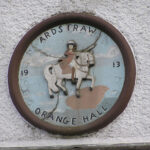2 July 1829: An elderly postman and a one-legged Waterloo veteran set out in ironed clogs to walk from Hebden Bridge to Heptonstall during a thunderstorm
Leeds Mercury. 1829/07/11. Singular Effect of Lightning. Leeds. Get it:
.Excerpt
On Thursday last, as the foot post, who carries letters from Hebden-Bridge to Heptonstall, was on his way to the latter place during a thunderstorm, his clogs, which were hooped with iron, attracted the electric fluid, which split one of his feet in two, and separated the heel from the other. The unfortunate man, who is 78 years old, was accompanied up the hill by a military pensioner, who had left one of his legs on the plains of Waterloo, and consequently had only one ironed clog, which was split to pieces without injuring his foot.
Comment
Comment
I think this must have been July 2nd 1829 rather than 9th – I take Daniel Galef’s point in reply to me here:
In 1829, when a Leeds newspaper published on Saturday refers to a lightning strike near Hepstonstall on "Thursday last", I wonder whether "last" actually refers to the most recent Thursday for which they might reasonably be expected to have out-of-town news, i.e. 9 days previous pic.twitter.com/LyrGDtinqI
— SingingOrganGrinder (@elorganillero) November 17, 2022
Hebden Bridge and Heptonstall were symbiotic, so, apart from the sensation, this may have been quite important local news:
Mills down in the valleys made use of water power, first for fulling cloth as early as the twelfth century and for carding and spinning by the end of the eighteenth. This spatial distinction between the powered and hand processes created paired settlements, with mill communities such as Hebden Bridge in the valleys and weaving villages like Heptonstall on the hilltops. This kind of pairing was gradually brought to an end in the second half of the nineteenth century by further technological innovation as steam power replaced water power and integrated, valley-bottom mill complexes were built which included all processes from carding to weaving and dyeing under one roof (Palmer 1998).
Real men wore ironed clogs:
“Bar-foot” is a common term in North Lancashire, and it is very often used in conjunction with “bare legg’d,” “bar-foot and bare-legg’d” being the phraseology in which a person destitute of covering for the feet is usually described. But the most curious form of using the word is when applied to clogs. It is a usual form of expression to say that a person wears “bar-foot clogs” when the alder forming the sole of the clog is not encased in iron. I remember the time when it was infra dig. for a man to wear “caulked” – or, as we expressed it, “cawker’d” – clogs, and they were only worn by girls and women. A school boy would scorn to wear the “caulked” soles. Indeed, it was hyperfeminine to wear them. The recognised form of clog had a casing of iron on the edge of the sole, and this was worn by the men and boys, and by the more vigorous women and girls. Some of these “iron’d clogs,” as they were called, are still to be met with in parts of the country, where good old customs happily die hard. “Barfoot clogs” was another term for poverty, and although we are told that
It was written on a wall in Rome,
Ribchester was the richest town in Christendom,the “barfoot clogs” of the hand-loom weavers of the old village which supplanted the wealthy Roman town was proverbial of their poverty. I knew very well a farmer in the Ribble valley who used to say that he always listened out for the sound of the “barfoot clogs” in Ribchester to tell what sort of weather it was going to be. It is perhaps safe to assume that as he lived four miles down the valley from Ribchester, and was very deaf, this peculiar form of weather-indication – although, maybe, as good in itself as some other signs – would not be quite so often available for reference.
(E.K. 1883)
Something to say? Get in touch
Original
On Thursday last, as the foot-post, who carries letters from Hebden-Bridge to Heptonstall, in the parish of Halifax, was on his way to the latter place during a thunder-storm, his clogs, (wooden shoes) which were hooped with iron, attracted the electric fluid, which split one of his feet in two, and separated the heel from the other. The unfortunate man, who is 78 years old, was accompanied up the hill by a military pensioner, who had left one of his legs on the plains of Waterloo, and consequently had only one ironed clog, which was split to pieces without injuring his foot.
103 words.
Similar
 23 January 1643: Thomas Fairfax, the Rider of the White Horse, captures Leeds from the Beast with the help of Psalm 68
23 January 1643: Thomas Fairfax, the Rider of the White Horse, captures Leeds from the Beast with the help of Psalm 68 4 July 1838: 26 girls and boys drown trying to escape via a tunnel from flash flooding in Huskar Colliery, Silkstone, Barnsley, after the steam lifts fail during a rainstorm
4 July 1838: 26 girls and boys drown trying to escape via a tunnel from flash flooding in Huskar Colliery, Silkstone, Barnsley, after the steam lifts fail during a rainstormSearch
Donate
Music & books
Place-People-Play: Childcare (and the Kazookestra) on the Headingley/Weetwood borders next to Meanwood Park.
Music from and about Yorkshire by Leeds's Singing Organ-Grinder.



 Bluesky
Bluesky Extwitter
Extwitter